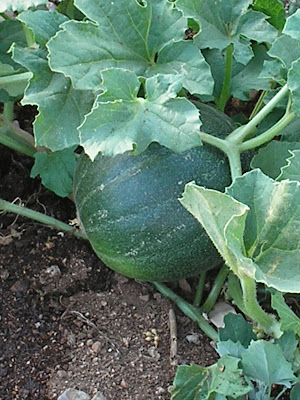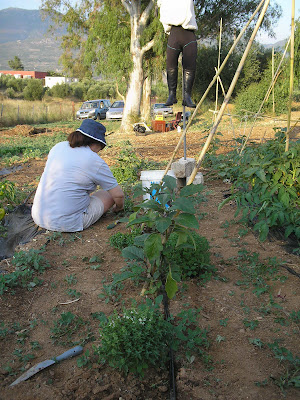Maintenance work
All agreed that afternoon work this week was the best especially since it is getting warmer and also any spraying (not chemical) needs to be done in low light.
On arrival and after greeting Mr. Darcy we wandered along our rows of babies to see what had been going on, noting along the way that all the dratted weeds had magically reappeared two-fold.
 |
| Checking out our babes, and.... Where did we plants the beans? |
The Rocket planted 2 weeks ago is growing very nicely and the Summer Spinach sown last sunday has sprouted. White fly is abundant on all the toms, so a big debate on how to get rid of the little sods which finalized in a soap and alcohol solution to be prepared in order to zap them! Meanwhile, nicotine potion was prepared and applied during the evening.
 |
| Rocket |
 |
| Pumpkin! |
 |
| Summer Spinach |
Construction
30 pieces of cane (FOC) were used to construction frames for our toms (getting heavier with fruit by the week) and also for our cucumbers.
.JPG) |
| All neat & tidy |
Lose & Addition
We lost an aubergine plant; it had not been well for the last couple of weeks. In order to have a continuous flow of crop some more plants were purchased along with a few more herbs (28 Euro) and some more plastic sheeting which does help keep the weeds down, but thinking about it now (and I need to do some research) just might be aiding our white fly infestation.
 |
| New Additions |
 |
| New tom and peppers in, along with a few summer lettuces |
 |
| Lemon Grass |
Nightfall
With the moon rising slowly and the sunsetting in the opposite direction; Brenda just kept on weeding, Teresa and Lisa cut lettuce, spring onions and handfuls of basil and the boyz really just wanted to get home due to hunger!
Tip of the Week
Whitefly: Biological control
Whitefly are best controlled in the greenhouse by biological control - using another insect that kills them and so do the work for you.
Encarsia is a small parasitic wasp which lays its eggs in the scales where the larvae develop and so kill the scale The larvae hatch into adults, which find more scales to parasitise. However, once it has done its job there is no food source for the larvae and so the lifecycle stops. If a further outbreak occurs then you have to re-introduce the encarsia. Luckily, encarsia rarely kills all its hosts, so there are usually some to carry on the lifecycle.
Encarsia is available from various mail order suppliers.
In order to keep your whitefly killers safely within the greenhouse where they will sort out your whitefly problem, it's a good idea to again use fleece over the vents and doors. And, you can't use insecticides (although soft soap can be used before the controls are introduced) while the controls are busy at work - so you'll have to trust them.
Can we find Encarsia here? Need to talk to friendly organic nursery in Kalamata!
 |
| Encarsia - Adult |
.JPG)


.JPG)
























.JPG)






